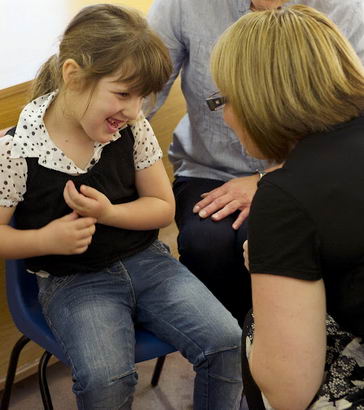
Neuroscientists strongly assert that the popular educational theories below have no scientific basis for their claimed effectiveness:
- Multiple intelligences (MI) theory;
- Experiential learning theory (Learning styles);
- The Mozart effect (ME) theory;
- Emotional intelligence (EI) theory;
- Educational kinesiology (Brain Gym).
Read Educational theories under challenge for brief descriptions and key reading guidance.

Learning by the brain depends on the development of multi-sensory
networks of neurons distributed across the entire brain. For example, a concept in science may depend on neurons being simultaneously
active in visual, spatial, memory, deductive and kinaesthetic regions, in both brain hemispheres.
Goswami and Bryant, 2007
This model of the brain, underpinned by extensive neuroscientific research, does not support such ideas as:
- Left-brain/right-brain learning;
- Unisensory 'learning styles' (visual, auditory or kinaesthetic);
- A modular view of the brain.
(Goswami and Bryant, 2007; Howard-Jones, 2009; Waterhouse, 2006)

Waterhouse cautions that in applying them to classroom practice, schools should be aware that apart from novelty interest for teachers and students, it is unlikely that they will have any real power to enhance student learning.
Students, teachers, researchers and theorists should remain open to new evidence from future research (Waterhouse, 2006).
A teacher writes:
[In training] this approach was heavily promoted, I looked forward to getting my hands on the book. It
felt then as if we were at the cutting edge of education.
I was so disappointed. As I tried to cobble some approaches which might suit my very needy pupils..., I looked for the research
behind this... There were 3 or 4 abstracts...; little or no information on the sample sizes or outcomes. It appeared that
none of the researchers was independent, and it seemed as if the publications were not peer-reviewed. None of the studies
appeared to have been replicated.
Non-specialist professionals vary in their attitude to neuroscience findings and can be divided into:
- Those who readily accept (and sometimes over interpret) the results;
- Those who completely reject the neuroscientific approach and consider the findings irrelevant;
- Those who are unfamiliar with and indifferent toward, neuroscientific research;
- Those who cautiously accept neuroscientific findings.
(Byrnes, 2001, in Greenwood, 2009)
Educators need to be able to critically evaluate this broadening of educational research; otherwise, they
will be vulnerable to the marketing.
Greenwood, 2009
The idea of Multiple Intelligences may not yet have a strong evidence base for effective teaching intervention, however the concept is useful for encouraging teachers to adopt a flexible and varied teaching approach (Goswami and Bryant, 2007).The idea that intelligence reflects a range of skills is an important one for children's ideas about their own ability and self-esteem.
Evidence based approaches regarding children's beliefs about their intelligence do exist and these theories also have an evidence base for effective teaching interventions. One such theory describes how teachers can promote a "growth mindset" in children.
Dweck identified different beliefs about intelligence among children:
- Intelligence is predetermined – therefore if learning is an effort for them, they are not intelligent;
- Intelligence can be changed by effort – if they do not understand something, they can do so by working harder.
(Dweck, 1999, 2006, in Goswami and Bryant, 2007)
Dweck has developed a range of teaching strategies which help children believe their intelligence can be changed by effort.

Waterhouse (2006) believes unproven approaches cause harm by:
- Presenting to educators unproven ideas as facts which conflict with what is known from scientific research;
- Supplanting more valuable learning experiences;
- Undermining the integrity of the education profession's teaching about acceptable scientific theory – that it must be 'logically consistent, open to change, based on current scientific knowledge', and 'must abide by the rules of evidence' (Waterhouse, 2006).
Dweck identified different beliefs about intelligence among children:
- Intelligence is predetermined – therefore if learning is an effort for them, they are
not intelligent; - Intelligence can be changed by effort – if they do not understand something, they can do so by working harder.
(Dweck, 1999, 2006, in Goswami and Bryant, 2007)
The idea that intelligence reflects a range of skills is an important one for children's ideas about their own ability and self-esteem; and the notion of multiple intelligences encourages teachers to adopt a flexible and varied teaching approach (Goswami and Bryant, 2007).
Brain Gym has been widely used in schools and the Innovation, Universities, Science and Skills Committee asked a question of the Department for Children Schools and Families as part of their "evidence check" initiative.
The questions they asked were:
- What scientific evidence is there that Brain Gym works?
- Does the Government support the scientific theory behind Brain Gym?
Read the response of the Department for Children, Schools and Families.
Taking a teaching approach that you currently use, or one of those listed in slide one, write a review of the evidence of its effectiveness for children's learning, using the criteria listed in this section.

Byrnes, J.P. (2001) Minds, Brains, and Learning. The New York, NY: Guilford Press.
Clark, L. (2009) Brain gym for pupils is pointless, admits Balls, Daily Mail (18.12.09) (accessed 12.1.12).
Dennison, P.E. and Dennison, G.E. (2010) Brain Gym: Teacher's Guide. Ventura, CA: Edu-Kinesthetics Inc.
Gardner, H. (1983) Frames of Mind. New York: Basic Books.
Gardner, H., and Moran, S. (2006) The science of multiple intelligences theory: a response to Lynn Waterhouse, Educational Psychologist, 41 (4), 227-232.

Goleman, D. (1995) Emotional Intelligence: Why It Can Matter More than IQ. New York: Bantam.
Goswami, U. and Bryant, P. (2007) Children's Cognitive Development and Learning. London: Esmée Fairbairn Foundation/University of Cambridge (accessed 12.1.12).
Greenspan, S.I. (1989) Emotional intelligence, in: Field, K., Cohler, B.J. and Wool, G. (eds) Learning and Education: Psychoanalytic perspectives, Madison, CT: International Universities Press.
Greenwood, R. (2009) Where are the educators? What is our role in the debate?, Cortex, 45 (5), 52–554.

Howard-Jones, P.A. (2009) Neuroscience, learning and technology (14-19), London: BECTA (accessed 12.1.12).
Howard-Jones, P.A. (2010) Introducing Neuroeducational Research: Neuroscience, education and the brain from contexts to practice. London: Routledge.
Kolb, D.A. (1984) Experiential Learning: Experience as the source of learning and development, Englewood Cliffs, NJ: Prentice-Hall.
Rauscher, F., Shaw, G. and Ky, K. (1993) Music and spatial task performance, Nature, 365 (14.10.93), 611.
Salovey, P., and Mayer, J.D. (1990) Emotional intelligence, Imagination, Cognition and Personality, 9, 185-211.

Waterhouse, L. (2006) Multiple intelligences, the Mozart effect, and emotional intelligence: A Critical Review, Educational Psychologist, 41 (4), 207–225.
The following additional resources will enable you to read around the subject:
Browse the Neuroeducational Research Network online.
Read this online study:
Howard-Jones, P.A. (2008) Potential educational developments involving neuroscience that may arrive by 2025. London: Beyond Current Horizons Project (accessed 12.1.12).